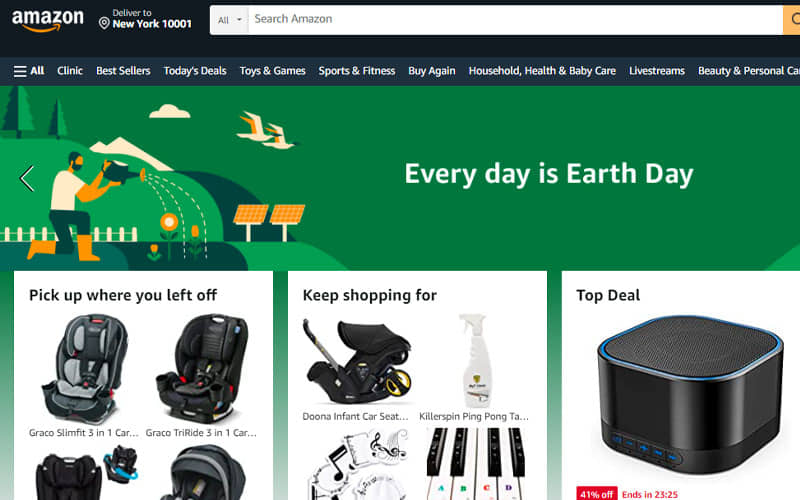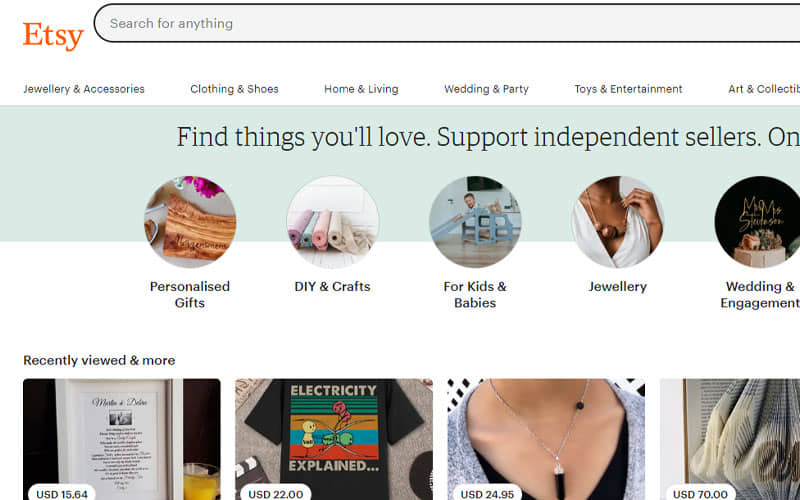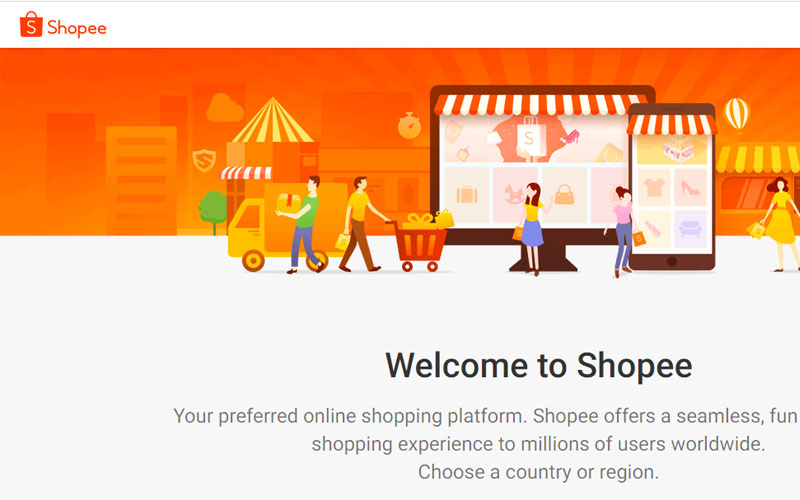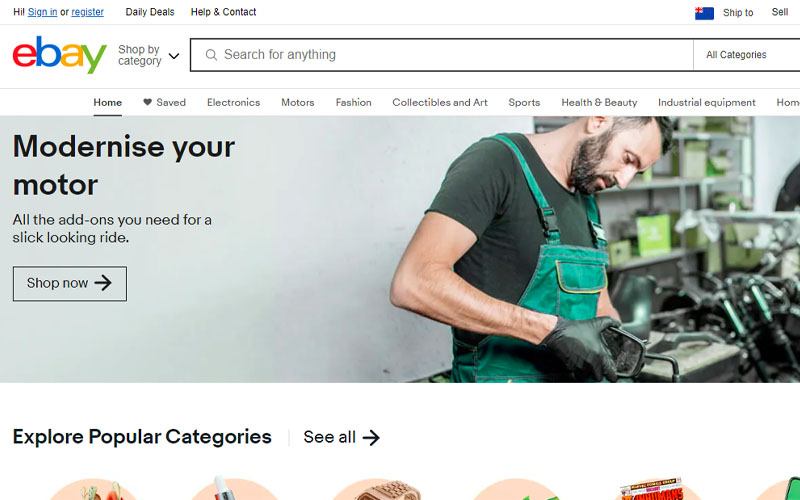A marketplace is a platform mediated by another company where several other shopkeepers can register and sell their products.
Ecommerce Marketplace is an online Shopping center where you can access qualified traffic to deploy your store and start selling. In other words, the marketplace is an online shopping center where you can buy and sell online.
This shopping model involves the owners (the companies that own the marketplaces) responsible for everything on their site, including the transaction processes.
Table of Contents
Types of Ecommerce Marketplaces
Below, we list the main types of marketplaces and the possibilities that each one offers:
👉 Marketplace B2C
Most large marketplaces focus on the B2C (business-to-consumer) public, a business model where the seller sells directly to the final consumer.
But nothing prevents you from advertising wholesale products on this type of platform. However, if you intend to sell only to other companies, niche players in B2B sales are the most suitable.
👉 Marketplace B2B
In general, B2B marketplaces focus on buying and selling products or services from business to business. They allow buyers to find reliable suppliers or negotiate better conditions directly with manufacturers.
👉 Marketplace C2C
C2C marketplaces allow consumers to sell new or used products to other consumers. That is, transactions are carried out between individuals rather than companies.
There are also dedicated platforms for providing services, where it is very common to find freelancers offering design, writing, programming, etc.
👉 Niche marketplace
Niche marketplaces are dedicated to specific segments. Unlike a general marketplace, where we see advertisements for different types of products, on a niche platform, we find goods related to a certain segment.
11 Best Ecommerce Marketplaces
There are many options on the market with different audiences and interests. We come with a list of online marketplaces to accelerate your sales by selling on Ecommerce marketplaces.
1. Inspire Uplift
Among the most trusted online Ecommerce marketplaces, Inspire Uplift offers buyers to interact with small business owners (sellers).
Due to its global platform, sellers can reach a larger customer base. Many products help you live an easy life, including digital goods, beauty and health products, clothing, chore-easing gadgets, and electronic devices.
This marketplace is known for offering some of the most competitive prices along with free worldwide shipping (for most sellers.) It has a user-friendly website that is easy to navigate and allows customers to browse the different product categories.
Customers can filter their search results based on price, popularity, and other criteria. Inspire Uplift’s website also includes photo product reviews from other customers, which can be helpful when purchasing.
With over 23,000,000 pageviews, this marketplace is considered as one of the top Ecommerce marketplaces for sellers since it offers them the opportunity to reach over 10 million customers.
It continues to grow and expand its product offerings, making it an exciting shopping place for online shoppers looking for something different.
Inspire Uplift offers several advantages to both sellers and buyers. Its free shipping policy is a great incentive for customers.
Categories: Home decor, health & beauty, care & wellness, digital arts & stickers, tech & electronics, baby care, home & garden, household tools, pet toys and accessories, clothing & shoes, jewelry & hair accessories, and more.
Fees: Charges 12% commissions and 3% for payment processing
Top Regions: United States, United Kingdom, Australia & Canada
Marketplace Type: B2C
2. Amazon

Founded in 1994, This Ecommerce marketplace is headed by Jeff Bezos. Initially, Amazon was a bookseller platform, mainly competing with local booksellers. Now this Ecommerce marketplace has become a go-to platform for selling goods and providing customer services.
One of the company’s differentials is the Prime subscription service which grants benefits such as free shipping, discounts on selected products, and access to the Amazon streaming service for customers.
In this way, sellers who adopt Prime delivery are likelier to stand out and sell more.
Categories: Tech, electronics, home and kitchen, beauty, personal care, toys, games, clothing, shoes, and jewelry, as well as health, household, and baby care.
Fees: Varies by categories, and the professional selling plan is $39.99 monthly.
Top Regions: United States, United Kingdom, Germany, Japan, and India
Marketplace Type: B2C and B2B
3. Etsy

Etsy is an ecommerce marketplace specializing in handmade, vintage, and unique items. It was founded in 2005 and has grown to become one of the largest online marketplaces for creative goods. Sellers on Etsy can create their own online shops and list items for sale.
Buyers on Etsy can browse different shops and products, search for specific items, and communicate directly with sellers.
Etsy’s focus on handmade and vintage goods and its emphasis on supporting independent artists and small businesses have helped create a unique and vibrant online marketplace.
Categories: Handmade art & collectibles, bags & purses, bath & beauty books, and movies & music.
Fees: A listing fee of 0.20 USD for each and a 6.5% transaction fee of the price displayed.
Top Regions: United States, United Kingdom, Canada, India, Italy, and France.
Type: B2C
4. AliExpress

AliExpress is an Ecommerce marketplace that is part of the Alibaba Group. It was founded in 2010 and has since become one of the largest business-to-consumer online marketplaces in the world, connecting buyers and sellers from around the globe.
Sellers on AliExpress are primarily based in China, although the platform also allows sellers from other countries. Buyers can browse different sellers and products, read reviews and ratings, and communicate directly with sellers before purchasing.
Categories: Clothing, Tech, Electronics, Home appliances, beauty, personal care, toys, games, sports goods, kitchen, garden, shoes, jewelry, and more.
Fees: Commissions vary between 5% and 8% on each product
Top Regions: India, Unites States, United Kingdom, Australia, & Canada
Type: B2B & B2C
5. Walmart

In 1962, Sam Walton opened the first Walmart store to help people save money so they could live better. In 2009, Walmart Marketplace was launched as an extension of Walmart.com, the popular online extension of Walmart stores for third-party sellers.
Walmart.com now offers third-party sellers who complement first-party brands’ existing products. Walmart’s marketplace is wider than US sellers since 5% of its current sellers are abroad.
Categories: Sell groceries, consumables, technology, office, books, entertainment, hardlines, apparel, and housewares.
Fees: From 6% to 15%, depending on the category and sales price
Top Regions: United States, India, Canada, Argentina, and the United Kingdom
Type: B2C
6. Flipkart

Flipkart is an Indian e-commerce company founded in 2007 by Sachin Bansal and Binny Bansal. It started as an online bookstore but later expanded its business to sell various products, including electronics, fashion, home essentials, and groceries.
As a marketplace, Flipkart allows third-party sellers to list and sell their products on its platform. Flipkart’s marketplace model has rapidly expanded its product offerings and customer base.
Customer service, payment processing, and order fulfillment are some of the services offered to these sellers by the company. In return, Flipkart charges a commission on every sale made through its platform.
Categories: Electronics, home and kitchen, fashion, books, and health and beauty.
Fees: Commission rates depend on the category and subcategory of the order
Top Regions: India, United Arab Emirates, Nepal, United States, and Saudia Arabia
Type: B2C
7. Shopee

Shopee is an eCommerce platform founded in 2015 that’s growing in popularity across Southeast Asia, including the Philippines, Singapore, and Malaysia.
Shopee has grown meteorically over the past 2 years due to the commercial conditions they provide for merchants to sell on their platform.
It provides discount coupons that can be used to get discounts on products in addition to various forms of payment with interest-free installments, making it easy for customers to make purchases.
At Shopee, anyone can also invest in advertising for their products. With Shopee Ads, you can promote your store and what you sell within the platform, gaining prominence in searches and navigation tabs.
Categories: Health & beauty, food & beverages, pets, electronics, lifestyle, and fashion.
Fees: Commission fees vary between 2% to 9%
Top Regions: Malaysia, Brunei Darussalam, India, United States, and Poland
Type: Early C2C and now B2C with the hybrid model.
8. Facebook

Facebook launched its Ecommerce marketplace in 2016, allowing users to buy and sell items within the Facebook app. This marketplace is designed to be a user-friendly platform where individuals and businesses can sell products to other Facebook users in their local area.
The Facebook marketplace is accessible to users aged 18 and above and available in more than 100 countries. Users can browse and search for items using keywords, categories, and filters.
This Ecommerce marketplace offers a secure payment system that allows users to pay for items using a credit card or PayPal.
Categories: Offers various products, including electronics, furniture, clothing, and cars
Fees: No listing or commission fee except the product advertising fees (CPM (Cost Per 1,000 views) – $14.9.
Top Regions: USA, UK, India, India, Indonesia, and Brazil.
Type: B2C, C2C and B2B
9. eBay

eBay is a global Ecommerce marketplace that was founded in 1995. One of the key features of eBay is its auction-style format, which allows sellers to set a starting price and let buyers bid on the item.
eBay offers various tools and services to help sellers manage their listings, including the ability to set up an online store and access analytics and reporting tools.
Categories: Books, business & industrial, clothing, shoes & accessories, collectibles, consumer electronics, crafts, dolls & bears, and home & garden.
Fees: Fees vary for each category, between 5% and 15% in fees
Top Regions: United States, Mexico, India, Brazil, and Chile
Type: C2C, and B2C
10. Wayfair

The Wayfair Ecommerce marketplace was founded in 2002 and offers everything you need for your home and life. Wayfair is a company headquartered in Boston, USA, and Berlin, Germany, that has been creating and improving homes.
Categories: Textiles, homewares, furniture, home décor, garden items, and home appliances.
Fees: Wayfair will be charged a 2% commission on sales.
Top Regions: United States, India, South Africa, Taiwan, and Canada
Type: B2B, and B2C
11. Target

Target is a well-known retail chain in the United States that operates an Ecommerce marketplace. The Target marketplace offers various products, including electronics, clothing, home goods, and groceries.
To sell your product on Target.com, you must contact their merchandising or sourcing team and submit a proposal. If your product is selected, you’ll set up an account on Target’s Partners Online portal.
There needs to be more online information about becoming a Target vendor, the Target vendor application, and Target fees. Target prefers to sell products with a proven track record, making the retailer a better choice than a new online retailer.
Categories: Clothing, shoes & accessories, home & patio, baby, electronics, school & office, toys, sports, fitness & outdoors, and entertainment.
Fees: Sellers must pay a 5 to 15% commission rate to sell on the target ecommerce marketplace.
Top Regions: United States, Canada, Australia, India, and Mexico
Type: B2C
Factors to consider when choosing an ecommerce marketplace:
When choosing an ecommerce marketplace, there are several factors that you should consider. These include the size and popularity of the marketplace, the types of products sold on the platform, the level of competition, and the platform’s ease of use.
1. Understanding your target audience and their shopping habits:
An ecommerce marketplace should be chosen based on the target audience’s shopping habits. For example, your target audience is primarily tech-savvy millennials. In that case, consider a marketplace with a strong mobile presence and features like social media integration.
2. Evaluating fees and costs associated with each marketplace:
Ecommerce marketplaces have different fee structures and costs associated with selling on their platform.
Some charge a flat fee per transaction, while others take a percentage of the sale price. Evaluating these costs and determining which marketplace offers the best value for your business is important.
3. Examining the policies and guidelines of each marketplace:
Before choosing an ecommerce marketplace, it’s essential to examine the policies and guidelines of each platform.
This includes rules around product listings, payment processing, and shipping, among other things. Ensure that you understand these policies and that they align with your business goals and values.
Benefits Of Selling on Ecommerce Marketplace
➡️ Visibility
Large marketplaces usually receive thousands of visits every day. In fact, according to a Forbes study, there were almost 90 billion U.S. social commerce shoppers in 2021. So, you can use this visibility to convert visitors into customers for your brand.
This is very beneficial for those just starting; after all, generating traffic for e-commerce requires a lot of strategic knowledge and a certain amount of investment.
➡️ Credibility
In general, people tend to need more confidence about buying from stores that have been in the market for a long time. This way, you can use a marketplace’s Credibility to bolster your store.
It is even super common to find ads where the marketplace guarantees the delivery of items sold by partners. This gives more credibility to consumers who still need to learn about your store.
➡️ Easy to start selling and low initial cost
To join a marketplace, you must register on the desired platform, create ads and start sales.
You don’t need a big investment to spend a lot to start selling via the marketplace, as the entire infrastructure is already in place, so there is no need to build a website from scratch.
➡️ Integrations with various tools
Some marketplaces allow integration with external tools. You can use CRMs, ERPs, software, and external logistics services. This makes it easier to offer competitive differentials to your customer base.
Final Words
Increase your sales and revenue with the above-discussed popular Ecommerce marketplaces.
Hopefully, this comprehensive guide will help you understand the best Ecommerce marketplaces for earning money. Instead of opening a single store, you can attract more customers and increase sales by creating your seller account at Inspire Uplift.
Start promoting your products on Inspire Uplift immediately and reap your rewards.


